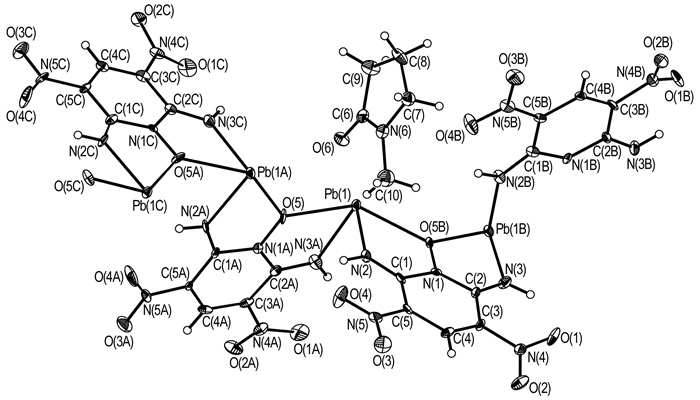2. 南京理工大学化工学院, 江苏 南京 210094;
3. 江苏大学环境与安全工程学院, 江苏 镇江 212013;
4. 江苏大学能动学院, 江苏 镇江 212013;
5. 西安近代化学研究所, 陕西 西安 710065;
6. 甘肃银光化学工业集团有限公司, 甘肃 白银 730900
2. School of Chemical Engineering, Nanjing University of Science and Technology, Nanjing 210094, China;
3. School of Environment and Safety Engineering, Jiangsu University, Zhenjiang, Jiangsu 212013, China;
4. School of Environment and Safety Engineering, Jiangsu University, Zhenjiang, Jiangsu 212013, China;
5. Xi′an Modern Chemistry Research Institute, Xi′an, 710065, China;
6. Research institute of Gansu Yinguang Chemical Industry Group, Baiyin, 730900, China
由于新型高性能含能催化剂相对于传统金属及其氧化物等惰性催化剂具有燃烧行为可调, 能量水平高等优点, 成为固体推进剂燃烧催化剂发展热点[1]。其中, Pb(Ⅱ)含能催化剂是固体推进剂中极为重要的一类燃烧催化剂, 它的加入, 可显著提高固体推进剂燃速, 降低压力指数。近年来, 新型高性能Pb(Ⅱ)含能催化剂的研究和应用已引起国内外广泛关注[1-9]。本课题组前文报道了2, 6-二氨基-3, 5-二硝基吡啶-1-氧化物(ANPyO)Pb(Ⅱ)含能配合物(Pb-ANPyO, 图 1)的晶体结构, 热分解行为和催化性能[10], 研究表明: Pb-ANPyO是一种新型高性能含能催化剂, 相对于国内外已报道的Pb(Ⅱ)含能催化剂, Pb-ANPyO具有感度低和热稳定性高等优点, 在钝感含能催化剂领域具有潜在的应用。参考文献[10]所得Pb-ANPyO分子中含有一定数量的N-甲基吡咯烷酮(NMP)小分子, 配合物能量水平降低。为提高Pb-ANPyO能量水平, 获得安全性能和热分解特性参数。本研究以ANPyO和醋酸铅为原料, N, N-二甲基甲酰胺(DMF)为溶剂, 得到Pb-ANPyO, 对配合物的结构进行了表征, 同时对配合物机械感度, 热分解行为, 非等温热分解反应动力学和热力学及热安全性进行了测试、分析和计算, 为Pb-ANPyO应用于固体推进剂提供基础。
2 实验 2.1 试剂、仪器与测试条件ANPyO参考文献[11]合成; 醋酸铅, 分析纯, 国药集团化学试剂有限公司; DMF, 试剂纯, 南京化学试剂股份有限公司。
DSC823e差示扫描量热仪, 瑞士METTLERTOLED公司, 试样量1.0~1.5 mg, 升温速率2.5, 5, 10, 15 ℃·min-1, 升温区间25~500 ℃, N2流量为25 mL·min-1; 热重分析仪, 瑞士METTLER TOLEDO, 型号TGA/SDTA851e热分析仪, 试样量1.0~1.5 mg, 升温速率2.5, 5, 10, 15 ℃·min-1, 升温区间25~500 ℃, N2流量为25 mL·min-1; MAGNA-760型傅里叶变换红外光谱分析仪, 美国NICOLET公司, KBr压片; 德国Vario EL Ⅲ CHNOS元素分析仪; MEL-TEMP熔点仪, 美瑞泰克集团-先德科技仪器; PHI-5702型X射线光电子能谱仪。
根据GJB772A-1997标准方法601.2-特性落高法和602.1爆炸概率法对样品进行机械感度测试。撞击感度测试条件:采用WL-1型撞击感度仪,试验用2.5 kg落锤,样品重50 mg;摩擦感度测试条件:采用WM-1型摩擦感度仪,样品重20 mg,90 ℃摆角,表压3.92 MPa。
2.2 Pb-ANPyO合成Pb-ANPyO参考文献[10]合成, 采用DMF作反应溶剂。
3 结果与讨论 3.1 Pb-ANPyO结构图 1为Pb-ANPyO晶体结构[10], 采用元素分析, FTIR和XPS测试和分析对合成的配合物进行结构鉴定。
元素分析:理论值(%): C, 14.28; H, 0.71; N, 16.66。实测值(%): C, 14.26; H, 0.72; N, 16.67。图 2为Pb-ANPyO FTIR图谱, 其中, 3337 cm-1(NH), 3056 cm-1(CH), 1583 cm-1(NH), 1509 cm-1(吡啶环), 1487 cm-1(NO2), 1359 cm-1 (NO2)和1306 cm-1(N→O)分别为配合物分子中特征官能团NH, CH, 吡啶环, 硝基和N→O红外吸收峰。此外, 图 2并未出现H2O和DMF的特征吸收峰, 证明Pb-ANPyO分子中不含H2O和DMF小分子。
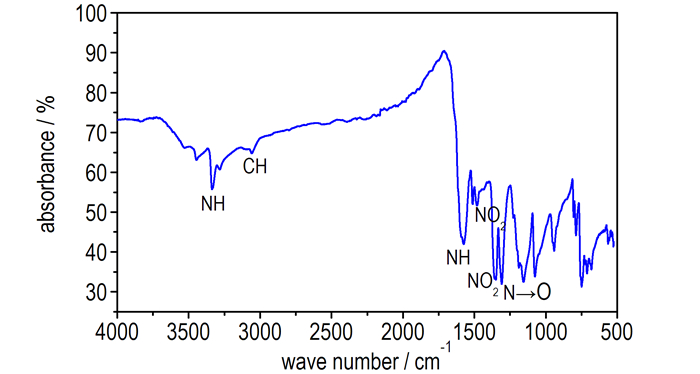
|
图 2 Pb-ANPyO的FTIR图谱 Fig.2 FTIR spectrum of Pb-ANPyO |
采用XPS对Pb-ANPyO结构作进一步验证, 结果见图 3和图 4。由图 3可知, 配合物含Pb, C, N, O四种元素。其中, 18.5, 134.9, 138.2, 412.3, 436.5 eV和641.7 eV为Pb(Ⅱ)特征吸收峰, 证明配合物中含有Pb(Ⅱ)离子。图 4(b)中O1s的拟合峰530.1 eV为Pb-ANPyO分子中Pb—O键的特征吸收峰, 进一步证明配合物分子中含有Pb(Ⅱ)离子。此外, 由C1s和O1s分峰拟合结果可知, Pb-ANPyO分子中C和O元素分别存在四种和三种价态: 283.1(C—H), 283.6(C=C), 284.5(C—N), 287.2(C=N), 530.1(O-Pb), 531.2 eV(O—N, N→O)和532.3 eV(O—N, NO2), 分别与配合物分子中不同的官能团和元素对应。其中, Pb-ANPyO分子中主要官能团XPS特征峰值与ANPyO Co(Ⅲ)配合物[12]相应的测试和分析结果相近。
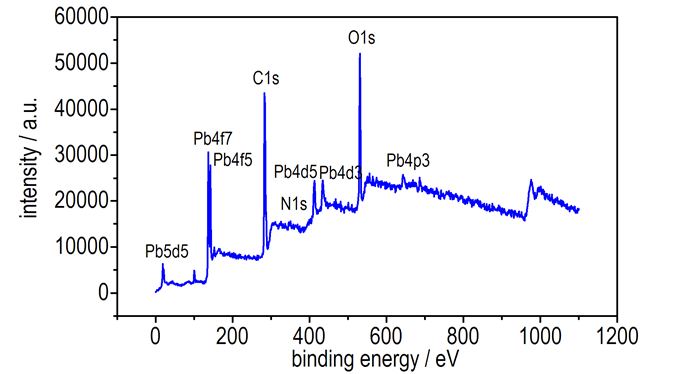
|
图 3 Pb-ANPyO的XPS图谱 Fig.3 XPS pattern of Pb-ANPyO |
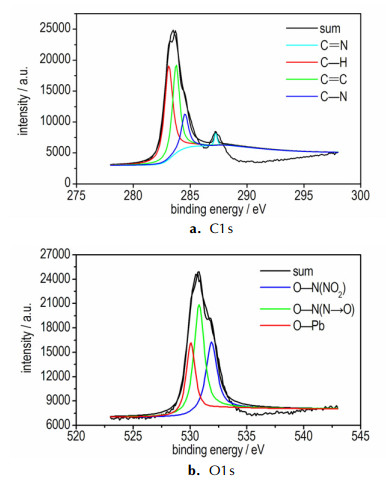
|
图 4 Pb-ANPyO C1s和O1s分峰的拟合结果 Fig.4 Fitted results of C1s and O1s peaks of Pb-ANPyO |
由元素分析FTIR和XPS测试和分析结果可知, 所得Pb-ANPyO不含H2O和DMF等小分子, 分子式为Pb(C5H3N5O5)。
3.2 Pb-ANPyO机械感度本研究测试了Pb-ANPyO的机械感度, 并与文献[11]ANPyO的相关结果作对比, 结果见表 1。由表 1可知, Pb-ANPyO撞击感度和摩擦感度分别为238 cm和0, 与ANPyO基本相当。
| 表 1 ANPyO和Pb-ANPyO撞击感度和摩擦感度结果对比 Tab.1 Comparison of the impact sensitivity results and the friction sensitivity ones of ANPyO and Pb-ANPyO |
ANPyO分子中的氨基与硝基分别形成分子内、分子间氢键, 晶体呈类似于石墨的平面层状结构[13]。这种结构受到外界能量刺激作用时, 能量可在整个平面间传递, 使得单个ANPyO分子承受的能量大大减少。此外, 类似于石墨的层状结构能够有效降低层与层之间、颗粒与颗粒之间的摩擦, 减少热点发生的概率, 这是ANPyO感度较低主要原因。此外, π电子共轭效应和氨基供电子效应也是ANPyO感度较低部分原因。
ANPyO与Pb(Ⅱ)形成配合物后, 一方面, 配体ANPyO脱去两个氢原子与Pb(Ⅱ)形成配位键, 显著削弱ANPyO分子中氨基与硝基分子内、分子间氢键作用[10]。ANPyO平面层状的晶体结构遭到破坏, 这不利于降低Pb-ANPyO感度。另一方面, 配体ANPyO通过[Pb—O]n链桥接作用, 形成了无限延伸聚合物结构, 配体ANPyO之间的连接作用得到加强。当受到外界能量刺激作用时, 能量可在多个配体ANPyO之间分散, 单个配体ANPyO所承受的能量显著减少。这种结构特征与Na[CL-14·2H2O]无限延伸的[ONaN]n链状结构具有相似性[14]。文献[14]结果表明, 这种结构特征有利于降低Pb-ANPyO感度。此外, 配体ANPyO与Pb(Ⅱ)形成共面性的五元螯合环有利于提高配合物的稳定性, 也有利于降低Pb-ANPyO感度[10]。
基于以上分析, 无限延伸聚合物结构, 以及配体ANPyO与Pb(Ⅱ)特殊的配位方式, 可能是Pb-ANPyO感度较低主要原因。
3.3 Pb-ANPyO热分解行为图 5为Pb-ANPyO的TG-DSC曲线。由图 5可知, Pb-ANPyO热分解过程分为2个阶段:第1阶段为吸热熔融阶段, 发生于243.2~279.3 ℃, 峰顶温度为265.0 ℃。第2阶段为剧烈放热分解阶段, 发生于297.5~352.4 ℃, 峰顶温度为332.6 ℃。显然, 本文合成的Pb-ANPyO热分解行为相对于文献[10](含有NMP小分子, 升温速率10 ℃·min-1)已发生显著变化: (1)最大放热峰峰温提前约8.5 ℃; (2)NMP放热分解峰完全消失。这与3.1结果一致。
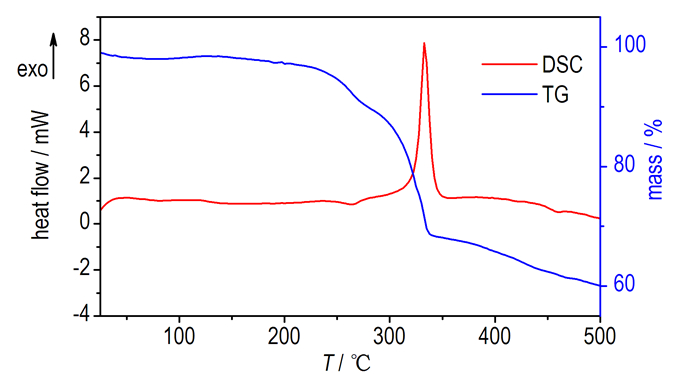
|
图 5 Pb-ANPyO升温速率10 ℃·min-1条件下TG-DSC曲线 Fig.5 TG-DSC curve of Pb-ANPyO at a heating rate 10 ℃·min-1 |
图 6为Pb-ANPyO在2.5, 5, 10, 15 ℃·min-1升温速率条件下的DSC曲线, 根据不同升温速率条件下Pb-ANPyO的DSC曲线的最大分解放热峰峰温, 分别采用Kissinger法[15]和Ozawa[16-17]法求得Pb-ANPyO非等温热分解反应动力学参数, 结果见表 2。由不同升温速率条件下Pb-ANPyO最大分解放热峰求得表观活化能EK=202.42 kJ·mol-1, 指前因子ln(AK)=15.49 s-1, EO=201.95 kJ·mol-1。
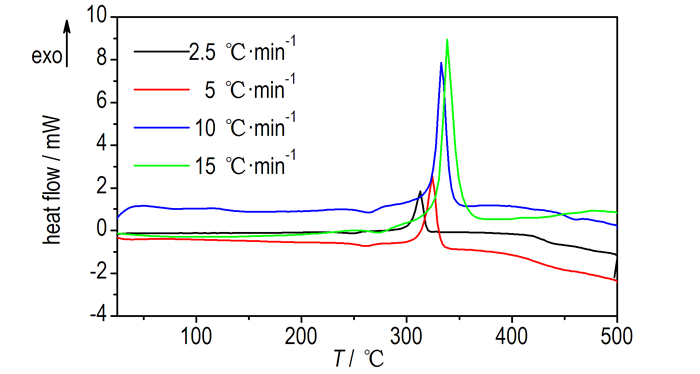
|
图 6 Pb-ANPyO不同升温速率条件下DSC曲线 Fig.6 DSC curves of Pb-ANPyO at the different heating rate |
| 表 2 Pb-ANPyO非等温热分解反应动力学参数 Tab.2 Kinetic parameters for nonisothermal thermal decomposition reaction of Pb-ANPyO |
将Pb-ANPyO不同升温速率条件下得到的TG曲线转化为对应的α-T曲线(α为反应深度, 0 < α < 100), 选择Pb-ANPyO在剧烈分解放热阶段(12 < α < 32)α-T曲线为研究对象, 采用Ozawa[16-17]法求得Pb-ANPyO在剧烈分解放热阶段非等温热分解反应动力学参数, 结果见图 7和表 3。由图 7和表 3可知, Pb-ANPyO在剧烈放热分解阶段(12 < α < 32)计算所得动力学数据的线性相关性较好, Pb-ANPyO在该阶段(12 < α < 32)平均活化能E=197.40 kJ·mol-1, 与DSC曲线法计算所得活化能数据较为接近, 表明TG曲线法计算所得活化能数据具有一定可靠性。
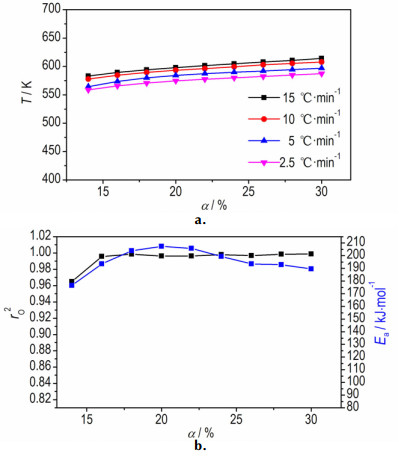
|
图 7 Pb-ANPyO放热分解反应的α-T曲线和α-Ea曲线 Fig.7 α-T and α-Ea curves for the exothermic decomposition reaction of Pb-ANPyO |
| 表 3 Pb-ANPyO放热分解反应的非等温动力学参数 Tab.3 Nonisothermal reaction kinetic parameters for the exothermic decomposition reaction of Pb-ANPyO |
根据GJB772A-1997方法505.1, 以及文献[18]ANPyO相关曲线及参数, 按(1)式线性回归分别求得Pb-ANPyO和ANPyO加热速率趋于零时外推峰温Tpo。然后根据(2)~(4)式[19]分别求得Pb-ANPyO和ANPyO热分解反应热力学参数活化熵ΔS≠, 活化焓ΔH≠和活化自由能ΔG≠。
| $ {T_{{\rm{pi}}}} = {T_{{\rm{po}}}} + {\rm{b}}{\beta _{\rm{i}}} + {\rm{c}}{\beta _{{\rm{i2}}}} + {\rm{d}}{\beta _{{\rm{i3}}}}\;\;\;\;{i} = 1, 2, 3, 4 $ | (1) |
| $ A{\rm{exp}}(\frac{-E}{{\rm{R}}T})={{\rm{K}}_{\rm{B}}}\frac{T}{h}{\rm{exp}}(\frac{-\Delta {{\rm{G}}^{\ne }}}{{\rm{R}}T}) $ | (2) |
| $ \Delta {{H}^{\ne }}=E-RT $ | (3) |
| $ \Delta {{G}^{\ne }}=\Delta {{H}^{\ne }}-T\Delta {{S}^{\ne }} $ | (4) |
(1)~(4)式中, β为升温速率, ℃·min-1; KB为Boltzman常数, 1.3807×10-23 J·K-1, h为Plank常数, 6.626×10-34 J·S, T=Tpo, E=Ek, A=Ak, 分别为Pb-ANPyO和ANPyO热分解反应最大分解放热峰峰温、表观活化能和指前因子。
根据GJB772A-1997方法505.1中的Zhang-Hu-Xie-Li法及文献[20], 按以下公式计算Pb-ANPyO和ANPyO自发火温度Tbpo:
| $ {{T}_{\rm{bpo}}}=\frac{{{E}_{\rm{K}}}-\sqrt{E_{_{K}}^{^{2}}-4{{E}_{\rm{K}}}R{{T}_{\rm{po}}}}}{2R} $ | (5) |
式中, EK为DSC曲线法所得Pb-ANPyO和ANPyO表观活化能, J·mol-1; R为理想气体常数, 8.314 J·mol-1·K-1。将EK和Tpo代入公式(5)求得Pb-ANPyO和ANPyO自发火温度分别为586.6 K和632.0 K。
Pb-ANPyO和ANPyO自加速按公式(6)计算[21]:
| $ {{T}_{\rm{SADT}}}={{T}_{\rm{bpo}}}-\frac{R{{T}^{2}}_{\rm{bpo}}}{{{E}_{\rm{K}}}} $ | (6) |
将EK和Tbpo代入公式(6)求得Pb-ANPyO和ANPyO自加速分解温度分别为572.4 K和620.8 K。
Pb-ANPyO和ANPyO热分解反应热力学和热安全性参数计算结果见表 4。
| 表 4 Pb-ANPyO与ANPyO热分解反应热力学和热安全性参数的对比 Tab.4 Comparison of thermodynamic and thermal safety parameters for the thermal decomposition of Pb-ANPyO and ANPyO |
由表 4, 本文3.3和文献[10-11, 22-23]结果可知, Pb-ANPyO热安全性参数相对ANPyO有一定程度降低, 但相对于ANPyO其他含能配合物如Cu(Ⅱ)、Fe(Ⅲ)和Co(Ⅲ), Pb-ANPyO热稳定性最优, 属于耐热型含能配合物。
综上所述[10, 22-23], 无限延伸聚合物结构可能是Pb-ANPyO热稳定性优于ANPyOCu(Ⅱ)、Fe(Ⅲ)和Co(Ⅲ)主要原因。本文结果可能为结构类似高耐热、低感度Pb(Ⅱ)含能配合物的结构设计和优化提供思路。
4 结论以ANPyO和醋酸铅为原料, DMF为溶剂, 得到Pb-ANPyO, 采用FTIR, 元素分析, XPS, 撞击感度, 摩擦感度, DSC和TG测试对Pb-ANPyO结构, 机械感度, 热分解行为, 热分解反应动力学参数和热力学参数, 以及热安全性进行了分析和计算, 结果表明:
(1) 配合物不含H2O和DMF小分子, 分子式为Pb(C5H3N5O5)。
(2) 配合物撞击感度和摩擦感度分别为238 cm和0, 机械感度与ANPyO相当。
(3) 配合物在25~500 ℃范围内分别有一个吸热熔融峰和放热分解峰, 峰温分别为265.0 ℃和332.6 ℃, 热分解反应的表观活化能EK=202.42 kJ·mol-1, 指前因子ln(AK)=15.49 s-1。
(4) 配合物自发火温度Tbpo=586.6 K, 自加速分解温度TSADT=572.4 K, 热分解反应热力学参数:活化熵ΔS≠=149.5 J·mol-1·K-1, 活化焓ΔH≠=197.7 kJ·mol-1和活化自由能ΔG≠=112.1 kJ·mol-1。
| [1] |
张国涛, 周遵宁, 张同来, 等. 固体推进剂含能催化剂研究进展[J].
固体火箭技术, 2011, 34(3): 319-323. ZHANG Guo-tao, ZHOU Zun-ning, ZHANG Tong-lai, et al. Advances on energetic catalyst for the solid propellant[J]. Journal of Solid Rocket Technology, 2011, 34(3): 319-323. |
| [2] |
赵凤起, 陈三平, 范广, 等. 含能配合物[J].
高等学校化学学报, 2008, 29(8): 1519-1522. ZHAO Feng-qi, CHEN San-ping, FAN Guang, et al. Synthesis, crystal structure and combustion catalytic activity of a novel energetic complex of[J]. Chemical Journal of Chinese Universities, 2008, 29(8): 1519-1522. |
| [3] |
樊学忠, 李吉祯, 张腊莹, 等. NTO铅铜衍生物对AP-CMDB推进剂燃烧性能和热分解的影响[J].
含能材料, 2007, 15(4): 316-319. FAN Xue-zhong, LI Ji-zhen, ZHANG La-ying, et al. Influence of lead(Ⅱ) and copper(Ⅱ) salts of NTO on the combustion characteristics and thermal decomposition of AP-CMDB propellant[J]. Chinese Journal of Energetic Materials(Hanneng Cailiao), 2007, 15(4): 316-319. |
| [4] |
Singh G, Felix S P. Studies of energetic compounds, part 29: effect of NTO and its salts on the combustion and condensed phase thermolysis of composite solid propellants, HTPB-AP[J].
Combustion and Flame, 2003, 132(3): 422-432. DOI:10.1016/S0010-2180(02)00479-0 |
| [5] |
Singh G, Felix S P. Studies on energetic compounds: part 36: evaluation of transition metal salts of NTO as burning rate modifiers for HTPB-AN composite solid propellants[J].
Combustion and Flame, 2003, 135(1): 145-150. |
| [6] |
陈沛, 赵凤起, 罗阳, 等. 2-羟基和4-羟基-3, 5-二硝基吡啶铅盐的热行为, 分解机理, 非等温分解反应动力学及其在推进剂中的应用[J].
化学学报, 2004, 62(13): 1197-1204. CHEN Pei, ZHAO Feng-qi, LUO Yang, et al. Thermal behavior, decomposition mechanism and non-isothermal decomposition reaction kinetics of lead salts of 2-hydroxy-3, 5-dinitropyridine and 4-hydroxy-3, 5-dinitropyridine and their application in propellant[J]. Acta Chimica Sinica, 2004, 62(13): 1197-1204. DOI:10.3321/j.issn:0567-7351.2004.13.003 |
| [9] |
赵凤起, 高红旭, 胡荣祖, 等. 4-羟基-3, 5-二硝基吡啶铅盐在固体推进剂燃烧中的催化作用[J].
含能材料, 2006, 14(2): 86-88. ZHAO Feng-qi, GAO Hong-xu, HU Rong-zu, et al. Combustion energy determination of lead salt of 4-hydroxy-3, 5-dinitropyridine and its catalysis for RDX-CMDB propellant combustion[J]. Chinese Journal of Energetic Materials(Hanneng Cailiao), 2006, 14(2): 86-88. |
| [10] |
Liu J J, Liu Z L, Cheng J. Synthesis, crystal structure and catalytic effect on thermal decomposition of RDX and AP: An energetic coordination polymer[J].
Journal of Solid State Chemistry, 2013, 200: 43-48. DOI:10.1016/j.jssc.2013.01.014 |
| [11] |
成健, 姚其正, 周新利, 等. 2, 6-二氨基-3, 5-二硝基吡啶-1-氧化物的合成新方法[J].
有机化学, 2008, 28(11): 1943-1947. CHENG Jian, YAO Qi-zheng, ZHOU Xin-li, et al. Novel synthesis of 2, 6-diamino-3, 5-dinitropyridine-1-oxide[J]. Chinese Journal of Organic Chemistry, 2008, 28(11): 1943-1947. |
| [12] |
Cheng J, Zhang R, Liu Z, et al. Thermal decomposition mechanism of Co-ANPyO/CNTs nanocomposites and their application to the thermal decomposition of ammonium perchlorate[J].
RSC Advances, 2015, 5(62): 50278-50288. DOI:10.1039/C5RA05903H |
| [13] |
Hollins R A, Merwin L H, Nissan R A, et al. Aminonitropyridines and their N-Oxides[J].
Journal of Heterocyclic Chemistry, 1996, 33: 895-904. DOI:10.1002/jhet.v33:3 |
| [14] |
Cheng J, Dong Y, Ma H, et al. Crystal structure, thermal decomposition, mechanical sensitivity of Na[J].
RSC Advances, 2015, 5(79): 64358-64367. DOI:10.1039/C5RA13156A |
| [15] |
Kissinger H E. Reaction kinetics in differential thermal analysis[J].
Analytical Chemistry, 1957, 29(11): 1702-1706. DOI:10.1021/ac60131a045 |
| [16] |
Ozawa T, Chem. A new method of analyzing thermogravimetric data[J].
Bulletin of the Chemical Society of Japan, 1965, 38(11): 1881-1886. DOI:10.1246/bcsj.38.1881 |
| [17] |
Doyle C D. Kinetic analysis of thermogravimetric data[J].
Journal of Applied Polymer Science, 1961, 5(15): 285-290. DOI:10.1002/app.1961.070051506 |
| [18] |
何志伟, 高大元, 刘祖亮. 2, 6-二氨基-3, 5-二硝基吡啶-1-氧化物及其黏结炸药的热分解动力学[J].
火炸药学报, 2009, 32(2): 32-36. HE Zhi-wei, GAO Da-yuan, LIU Zu-liang. Thermal decomposition kinetics of 2, 6-diamino-3, 5-dinitropyridine-1-oxide and its formulation Explosives[J]. Chinese Journal of Explosives &Propellants, 2009, 32(2): 32-36. |
| [19] |
胡荣祖, 高红旭, 赵凤起, 等. 1, 1′-二甲基-5, 5′-偶氮四唑水合物和2, 2′-二甲基-5, 5′-偶氮四唑的热安全性[J].
含能材料, 2011, 19(2): 126-131. HU Rong-zu, GAO Hong-xu, ZHAO Feng-qi, et al. Thermal safety of 1, 1′-dimethyl-5, 5′-azotetrazole and 2, 2′-dimethyl-5, 5′-azotetrazole[J]. Chinese Journal of Energetic Materials(Hanneng Cailiao), 2011, 19(2): 126-131. |
| [20] |
Zhang T L, Hu R Z, Xie Y, et al. The estimation of critical temperatures of thermal explosion for energetic materials using non-isothermal DSC[J].
Thermochimica Acta, 1994, 244: 171-176. DOI:10.1016/0040-6031(94)80216-5 |
| [21] |
汤崭, 杨利, 乔小晶, 等. HMX热分解动力学与热安全性研究[J].
含能材料, 2011, 19(4): 396-400. TANG Zhan, YANG Li, QIAO Xiao-jing, et al. On thermal decomposition kinetics and thermal safety of HMX[J]. Chinese Journal of Energetic Materials(Hanneng Cailiao), 2011, 19(4): 396-400. |
| [22] |
Liu J J, Liu Z L, Cheng J. Synthesis, crystal structure and properties of a novel tetra-nuclear Cu complex of ANPyO[J].
Journal of Solid State Chemistry, 2013, 197: 198-203. DOI:10.1016/j.jssc.2012.08.007 |
| [23] |
Liu J J, Liu Z L, Cheng J, et al. Synthesis, crystal structure and properties of energetic complexes constructed from transition metal cations (Fe and Co) and ANPyO[J].
RSC Advance, 2013, 3(9): 2917-2923. DOI:10.1039/c2ra22839d |
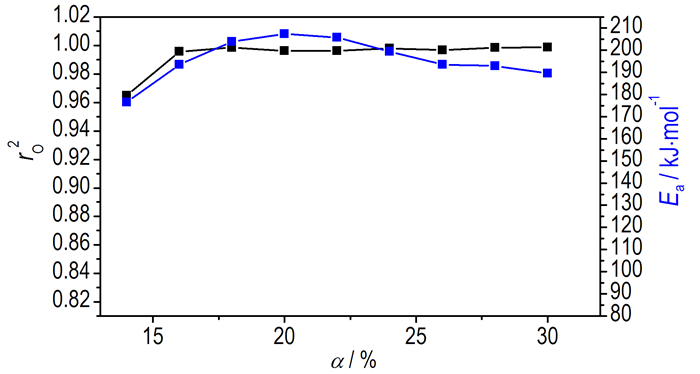
Energetic Pb(Ⅱ) complex of 2, 6-diamino-3, 5-dinitropyridine-1-oxide was synthesized. Its structure, mechanical sensitivity, thermal decomposition characteristic parameters were characterized.





